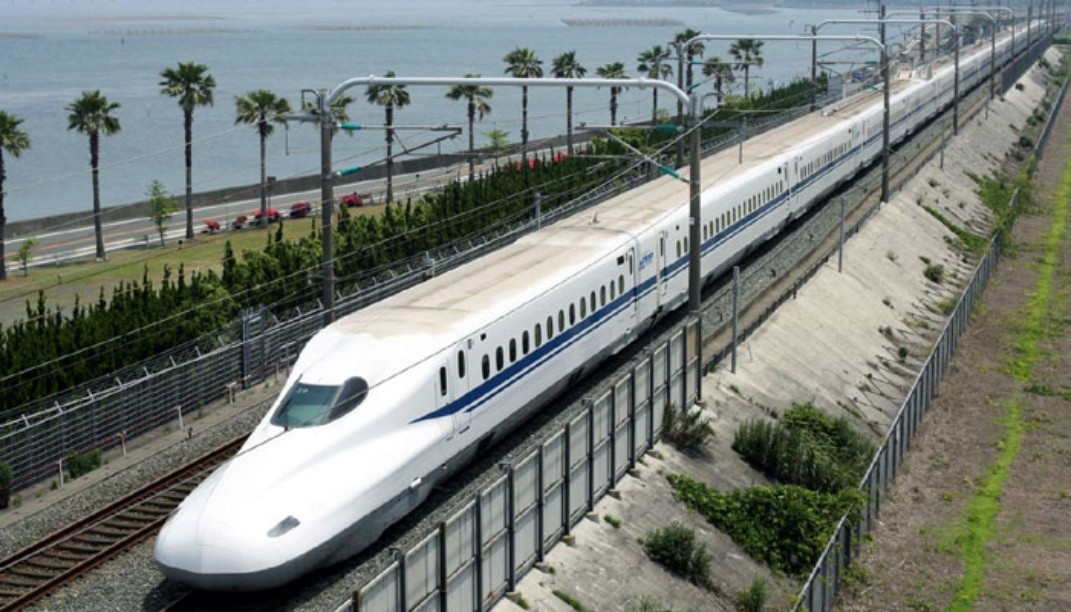
High-speed rail connection helps position Vietnam as a regional logistics hub: experts
Latest
 |
| High-speed rail connection helps position Vietnam as a regional logistics hub: An illustration of a train on a high-speed railway. (Photo: VNA) |
Economic necessity
High-speed trains have historically served as the lifeblood of logistics and transportation in many developed nations. The swiftness with which passengers and goods traverse vast distances, and the alleviation of highway congestion are just some of the invaluable benefits high-speed rail networks bring.
In the field of freight transport, high-speed rail can make a huge contribution.This train provides a fast and reliable method of transporting goods, ensuring timely delivery of products. This kind of transportation helps improve production and supply chain efficiency, save costs and enhance competitiveness in the global market.
Many experts and managers also believe that Vietnam cannot delay further in developing high-speed railways. Investment in high-speed rail is a long-term investment for the future. Developing the railway system, especially high-speed trains, will create a uniform transport network between roads, aviation, waterways and railways, increase effective connectivity between regions, and reduce logistics costs, contributing to economic development.
Talking to reporters, Dr. Majo George, Senior Lecturer of Logistics and Supply Chain Management, The Business School, RMIT University Vietnam commented: "Building a high-speed rail network will help significantly improve Vietnam's connectivity with neighboring countries. This helps trade and transport links with Cambodia, Laos and China become more effective, thereby positioning Vietnam as a regional logistics and marketing center."
According to him, the initiative to build a North-South high-speed railway promises to reshape Vietnam's economic picture, while enhancing the country's position as a strategic logistics center on the regional map. The capacity of a high-speed train network to facilitate the rapid movement of people and goods holds particular relevance for Vietnam. This innovation is more than a mere convenience; it is an economic necessity.
Three scenarios for the North-South express rail line project
Recently, the Ministry of Transport (MOT) submitted to the Standing Government an Action Plan for the development of Vietnam’s railway system, with an aim to begin work on North-South express rail line. According to sources, the North-South express rail line project focuses on 3 possible main scenarios:
Firstly, investing in new construction of a double-track North-South high-speed railway, rail gauge 1,435mm, design speed 350km/h, load 17 tons/axle, only operating passenger trains. The existing North-South railway line has been upgraded to transport goods, tourists and short-distance passengers. Total investment capital is about 67.32 billion USD.
Secondly, building a new double-track North-South railway, rail gauge 1,435 mm, design speed 200-250km/h, load 22.5 tons/axle, joint operation of passenger and freight trains. The existing North-South railway line has been modernized to transport goods, tourists and short-distance passengers. Total investment capital is about 72.02 billion USD.
Thirdly, investing in a double-track North-South railway line, rail gauge 1,435mm, design speed 350km/h, load 22.5 tons/axle, operating passenger trains and making provisions for cargo when available demand. The existing railway line was upgraded to carry goods, tourists and short-distance passengers. Total project investment capital is 68.98 billion USD. In this scenario, if investing in infrastructure, equipment, and vehicles to operate North-South freight trains, the project investment capital will be about 71.69 billion USD.
Notably, in the draft high-speed railway investment project on the North-South line, the Ministry of Transport proposed to choose scenario 3 for investment implementation.
What to do to realize the project?
Commenting on this draft project, the Ministry of Construction agreed with the policy of investing in the North-South high-speed railway, while the Ministry of Planning and Investment said that the 3 scenarios proposed by the Ministry of Transport were yet appropriate.
As for the experts, Associate Professor Dr. Doan Minh Tam, senior researcher specializing in transportation, said that they completely agree with the policy of investing in high-speed railways on the North-South line, but should only focus on choosing 2 options: Do not immediately invest in building a high-speed railway with a design speed of 350km/h, but only choose to invest in building a high-speed railway with a design speed of 200-250km/h and use it separately or building standard railway design speed is 150km/h.
According to Associate Professor, Dr. Tran Chung, Chairman of the Association of Investors and Transport Construction (Varsi), currently only 4 countries, Japan, Germany, Italy and Spain, own high-speed rail technology. 350km/h. China has just begun to access and is gradually mastering this technology.
Experts note that the Ministry of Transport has to carefully analyze scenario 3 based on two factors: scientific foundation and practical lessons from around the world.
 |
| High-speed rail connection helps position Vietnam as a regional logistics hub: Dr Majo George, Senior Lecturer of Logistics and Supply Chain Management, The Business School, RMIT University Vietnam. (Photo: Courtesy) |
Meanwhile, Dr. Majo George said that two primary alternatives confront Vietnam as it advances towards a high-speed train network. The first approach involves the establishment of elevated rail routes linking numerous provinces and cities. Although this approach may appear more practical initially, it bears the risk of substantial land acquisition disputes, leading to delays and increased costs.
The other alternative entails developing a network of elevated rail and automobile routes atop the current highways or through the seas. If through the ocean, there must be enough access/exit points at key provinces and cities. According to Dr. Majo George, while this approach necessitates higher initial investments, it offers the potential to mitigate wasteful land acquisition and reduce travel distances, thus yielding substantial long-term benefits. Recent technological advancements have made elevated rail systems feasible, including elevated rail lines atop existing highways, undersea tunnels, bridges, and floating rail tracks.
“The construction of elevated rail systems either atop highways or through the seas could expedite the establishment of a high-speed train network connecting the northern and southern regions, all while being designed to withstand various weather conditions and ensure year-round operability. With meticulous planning and environmental impact assessments, Vietnam can realise the goal of a high-speed train network that is economically advantageous and ecologically responsible”, Dr. Majo George said.
On November 14, at the meeting with Minister of Transport Nguyen Van Thang, World Bank Regional Vice President for East Asia and Pacific (EAP) Manula V. Ferro commented that the railway and expressway projects proposed by the Ministry of Transport are very necessary because of their high connectivity and significance not only for the socio-economic development of Vietnam but also for the region. Therefore, the World Bank (WB) can participate significantly in these projects.
At the same time, the WB commits to closely coordinate with the Ministry of Transport to be able to implement projects with capital support from the WB according to the time frame desired by the Prime Minister.
“It is important to note that implementing a high-speed train network calls for collaboration between government entities, private enterprises and international partners. Regardless of the chosen path, Vietnam possesses the technological and logistical capabilities to bring this vision to life”, said Dr. Majo George.





















